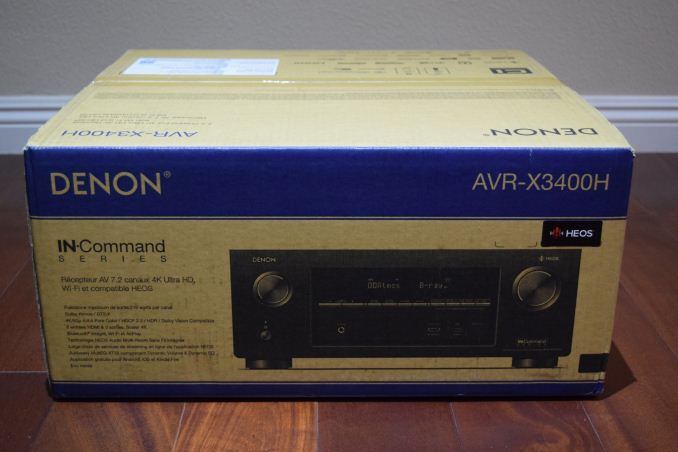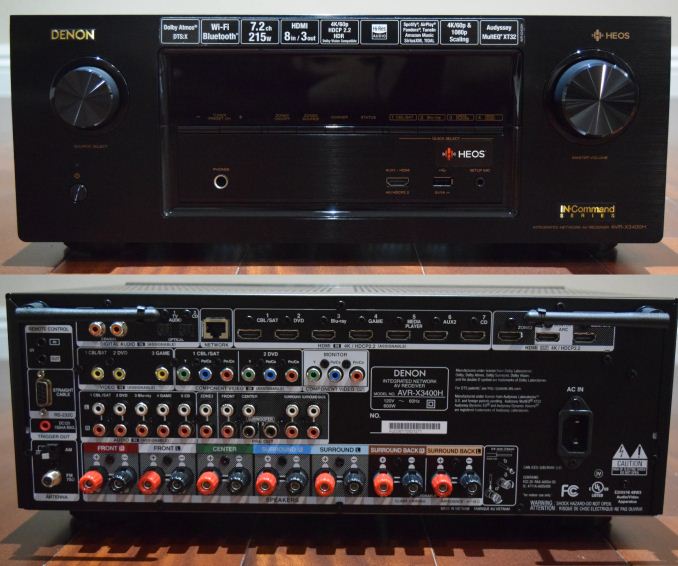A Budget Home Theater & PC Setup: 4K, HDR, UHD Blu-ray, and More
by Ganesh T S on December 26, 2017 8:30 AM ESTThe AVR: Denon X3400H
The choice of AVRs used to be a difficult one to make when support for different HD audio formats was not widespread. Now, the requirements boil down to the AVR being able to support the latest HD audio formats (Dolby Atmos and DTS-X), while matching the capabilities of the display in the chain. The additional features may help sway the purchase decision for consumers.
Budget considerations dictate the number of channels and display zones. We had to migrate from the 7.1 channel Pioneer Elite VSX-32 to a newer receiver capable of handling multiple HDMI 2.0 / HDCP 2.2 inputs with passthrough capabilities for various HDR formats. Based on my budget, I narrowed down the options to one of the models from Denon, Onkyo, Pioneer, and Yamaha. They are all in the same ball park in terms of pricing for a given feature set. We deferred to our friends at Wirecutter, who recommended the Denon AVR S730H.
I had been in touch with Denon regarding HEOS (their whole home audio solution) when the decision to go with a Denon AVR for our HTPC testing setup was taken. Upon discussing our project with them, Denon graciously agreed to sponsor the more advanced AVR X3400H for use in our testing.
The AVR X3400H targets the custom integrator channel. It has a number of additional features such as support for high end DSD audio, 4Kp60 upconversion for analog sources, multi-zone video outputs, higher power output, and support for eARC (Enhanced Audio Return Channel) to justify its higher price over the S730H. The presence of eARC makes it a bit more future-proof, as it allows for HD audio (including the new ones like Dolby Atmos and DTS-X) from the display sink to be returned to the AVR for decode and playback.
In the course of our testing, we found that the AVR received frequent firmware updates to add new features such as HLG passthrough. These point to a well-supported product. Even though the web control feature present in the previous generation Denon AVRs was missed, the Denon AVR Android app made up for it to some extent. None of the issues encountered in the course of the evaluation presented in this piece could be attributed to the Denon AVR X3400H.
If we had to give some suggestions to Denon for the improvement of the AVR X3400H, it would be to bring back the web control feature and shorten the time taken for firmware updates (though there is a facility to enable auto-updates that tries to install the new firmware when the AVR is not being used).
Speakers
Most readers upgrading their HTPC can opt to retain their existing speakers. In fact, I had the Boston Acoustics Horizon Series MCS100MDNT 5.1-channel speaker system from a 2008 purchase, along with a Jamo A306 HCS 5.1 speaker system from my 2011 home theater components upgrade. However, due to the remodel, I had to go in for in-ceiling speakers. I opted for a couple of the Polk Audio RC80i in-ceiling pairs for the rear and surround channel speakers. I bundled them along with ceiling speaker protective covers. The choice of speakers depends on the home theater size and other requirements. Currently, I am using the Jamo A306 speakers for the front, center, and subwoofer, with the Polk Audio RC80i for the other channels.












191 Comments
View All Comments
Golgatha777 - Tuesday, December 26, 2017 - link
It doesn't even make financial sense to try and do 4k Blu-ray on PC. The optical drive is $117 and the playback software, PowerDVD 17 is $40 currently. Add to this the requirement for specific motherboards and CPUs for the DRM chain, and you've more than paid for an XBox One S.Not to mention from my anecdotal experiences during the Bluray days, the software will be buggy as hell, the audio will be a pain in the ass to configure correctly, and you'll need to update the software (in this case PowerDVD) to the newest version down the road to keep up with the DRM key refreshes.
I built a HTPC years ago, and it's only still useful because I also use it to game on, and because of software that strips DRM off my discs. Now that commercial playback software must support Cinavia, it's useless to me as well for playing back ripped ISO images and media files; so I turn to open source programs and will keep my old hardware that ignores Cinavia, etc. for playback. For streaming and 4k discs, and XBox One S is much more cost effective, and the playback software will get updated for free going forward (support for new DRM keys, Dolby Vision, Dolby Atmos, etc.).
Golgatha777 - Tuesday, December 26, 2017 - link
Forgot the $26 for a SATA breakout drive enclosure for the 5.25in optical drive.edzieba - Tuesday, December 26, 2017 - link
For regular BD playback, by far the most painless experience is to just use AnyDVDHD and play the movie file directly off of the disc. No mucking about with menus (and waiting for a Java VM to load up just to RUN the menus!), no dealing with the steaming pile of garbage that is PowerDVD, no worrying about having to have an obtuse HDCP compatible chain, etc.Recent developments have shown HDCP 2 is on the way to being broken in a similar way, so soon the only practical requirements may be a BDXL capable drive and a HDR capable monitor/TV.
Fujikoma - Thursday, December 28, 2017 - link
I rip everything to an NAS and strip the Cinavia out of it. It also saves me the hassle of getting off my lazy butt and I can just stream anywhere in my house without a problem. My 4k BD drives cost me less than $70 (LG) and they both work fine for ripping (1950X TR with NVidia 1080). I can use my XBoneS for the odd video files (format, audio and sub options) I have and the Roku (boxes and the t.v. built-ins) work just fine for my h265 MP4s. I think you're right that the XBone platform would be a better option for 4k at this point. I'd use a 4k dedicated player for family, if no one games because it's less complicated. With family, fewer remotes and components has been the way to go. That's why I keep the amps and pre-amp setup in my computer room.The article, itself, doesn't really make any sense because there's too much skimping on the home theatre. Just easier to start with a good t.v. and audio setup with front speakers only, then add in the extra bells and whistles later. The list doesn't even contain a sub... which means a decent sound bar would be viable option to ceiling speakers as the surround setup isn't even in the cost breakdown.
rapster - Sunday, December 31, 2017 - link
How do you strip out Cinavia? Last I heard there still wasn’t a viable solution and would be very glad to hear that the situation has changed.Fujikoma - Sunday, January 7, 2018 - link
I'm not going to list the software, as it already had a run-in with the U.S. govt. and I don't feel like causing myself more hassle again even though I have a legal right to rip my own BD/DVD collection. Considering I (as does everyone in the U.S.) pay a 'fine' to the recording industry every time I purchase recordable/storage media for potential pirating/format change of stuff I own, my attitude towards it is even more jaded. Needless to say, the software was worth the money.Aikouka - Wednesday, December 27, 2017 - link
I wouldn't just flat-out recommend the Xbox One to anyone as a UHD BR player. The Xbox One's biggest problem is that it's far too noisy when playing UHD Blu-rays (disc noise), and it's quite easy to hear during quieter parts of a movie. I went that route to start with, and it only took me one movie to start researching alternatives. Unfortunately, most alternatives have issues too. Sony's player is arguably the one that has the least amount of awkward teething issues, but it'll never support Dolby Vision. (TCL's P605/P607 supports Dolby Vision.) LG was supposed to add it, but they pulled the update. I've also heard complaints of noise from other players. The only player that seems to get decent praise is Oppo's 203, but it's also over twice as expensive as the others (~$500).edlee - Thursday, December 28, 2017 - link
I understand the superiority of Dolby Vision, but the fact that its not widely supported in the tv market, only LG, roku tv, and vizio support the feature. All the support is going to the forthcoming HDR10+, i know its difficult to review right now, but its an open standard and royalty free. You will see support for it from more tv manufacturers as well. It has streaming support from Amazon on over 100 titles, and support is mostly coming from Netflix in the future.Reflex - Thursday, December 28, 2017 - link
And honestly until you get to 80" or higher projector style setups DV is unlikely to make a noticeable difference in image quality. DV is a nice to have, but not at all mandatory for a first class experience, at least not yet.HStewart - Friday, December 29, 2017 - link
I actually have Xbox One S and primary used it for UHD Blu-rays. There is difference in having it on PC then on Xbox - because you can also used it as 4K Monitor which is good fro graphics programs.I would agree for low cost it best to go for Xbox One S ( or X ).
I would think with this Pioneer drive - you should be able to get HULU in 4k on PC - but even with the Xbox you will need 13 megabit Internet connection to run 4k HULU.